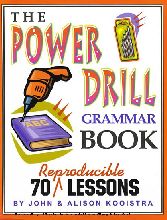Suchen und Finden
"The Power Drill Grammar Book (p. i-ii)
Introduction
What makes the Power Drill Grammar Book unique? It's fun. It's practical. The sample sentences are in step with modern times, and the grammar is a good mix of old school and modern theory. Most importantly, the Power Drills are focussed on students' primary needs -- error correction of their speech and writing in the formal register, and expansion of their range of expression.
Grammar instruction is important, but it is not the primary factor in the development of literacy skills. Most well-spoken, well-educated university graduates would have difficulty simply naming the parts of speech, and yet these students have an implicit and accurate grasp of thousands of complex grammar rules. Similarly, five-year-olds who can communicate effectively with their parents already have an implicit and accurate grasp of hundreds of grammatical concepts which neither they nor their parents could give a name to.
Many grammar drill books in actual fact do very little to aid students in the comprehension and enjoyment of their native or second language. These books focus too often on the naming of parts, and too often they offer confusing definitions. A classic example is the confident definition of the verb as ""the word that describes the action in a sentence."" This definition leaves out verbs such as BE and HAVE, and also leaves out most of the complexities of auxiliary verbs. A way around these problems is to follow these precepts:
1. Use grammar terminology only when it is necessary.
2. Use this terminology accurately, and always keep it as simple as possible.
3. Focus grammar drills on practical problems relating to formal correctness, or the kind of error correction that will augment success rates in students' academic careers.
4. Always, make the drills as interesting and enjoyable as possible. Grammar should be the most enjoyable, not the least enjoyable, of your subjects.
5. Finally, keep in mind that the most important factor in the development of writing skills -- even more important than exercises of the kind found in this book -- is the amount of reading your students do. Teachers should, above all, be interested in increasing the number of occasions in which they may immerse (but not drown!) their students in the pure joys of reading and writing.
A few suggestions to teachers:
1. Several exercises in the Power Drill book ask students to write yes or no in the blanks beside sentences. For fun, use substitute phrases or pictures. For ""yes"", students could draw happy faces, or use whatever terms are currently popular (""cool"", ""awesome"", etc.). For ""No"": a sad face, or ""uncool"", etc.
2. Relate as many lessons to the students’ own lives as you can. Use names and examples from their immediate community.
3. Have students work on their answers in teams. Each team passes their work to another team to be marked, while you announce the correct answers. This gives immediate feedback, helps the students to teach each other, saves you a load of marking, and makes a bit of fun.
4. Each unit has a ""Grammar Games"" lesson which focuses on fun and challenges. Take a lead from these lessons (9, 19, etc.), and incorporate other fun activities into the earlier drills, or apply the same games, such as ""I Spy,"" ""Crazy Sentences,"" and ""Guess the Adverb."""
Alle Preise verstehen sich inklusive der gesetzlichen MwSt.








